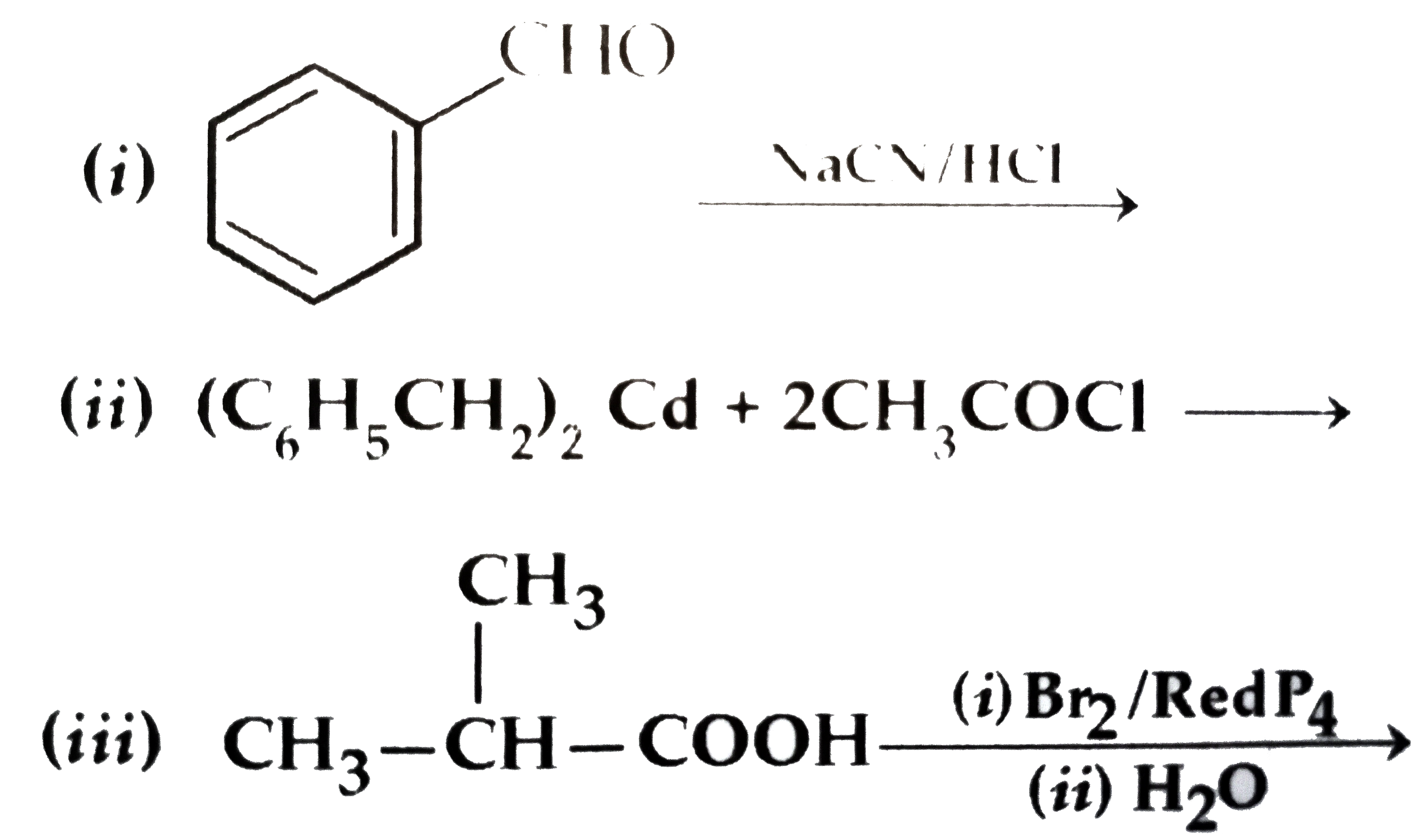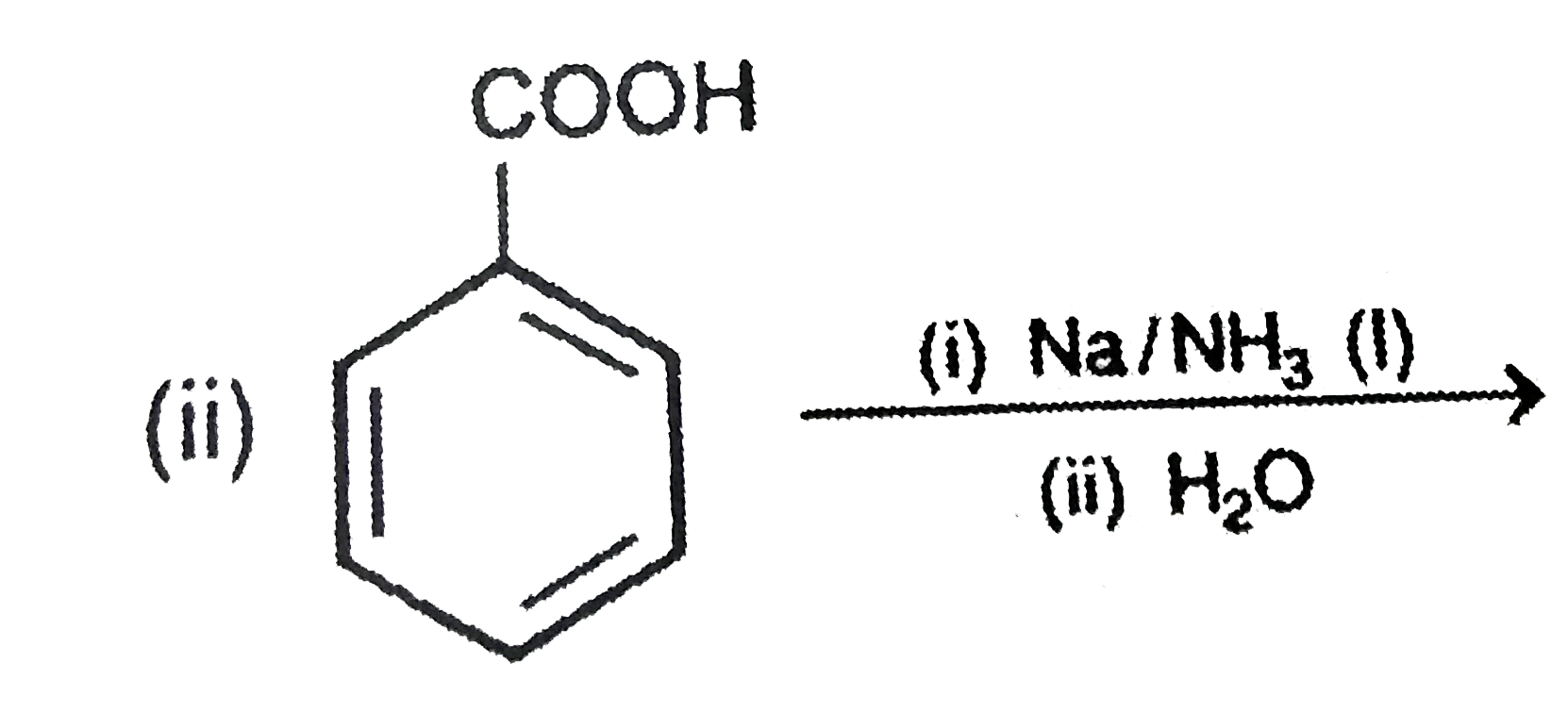Complete the following reaction :
C6H5COCl+(CH3)2Cdto
To complete the reaction between benzoyl chloride (C₆H₅COCl) and dimethyl cadmium ((CH₃)₂Cd), we can follow these steps:
Step 1: Identify the Reactants
The reactants are benzoyl chloride (C₆H₅COCl) and dimethyl cadmium ((CH₃)₂Cd). Benzoyl chloride is an acyl chloride, and dimethyl cadmium is an organometallic compound.
Step 2: Understand the Mechanism
Benzoyl chloride has a carbonyl group (C=O) bonded to a chlorine atom. The carbonyl carbon is electrophilic due to the electron-withdrawing effect of the chlorine atom. Dimethyl cadmium contains a nucleophilic methyl group (CH₃⁻) that will attack the electrophilic carbon of the carbonyl group in benzoyl chloride.
Step 3: Nucleophilic Attack
The nucleophile (CH₃⁻) from dimethyl cadmium attacks the carbonyl carbon of benzoyl chloride. This results in the formation of a tetrahedral intermediate where the carbonyl bond (C=O) breaks, and a new bond is formed between the carbonyl carbon and the methyl group.
Step 4: Elimination of Chloride Ion
After the nucleophilic attack, the tetrahedral intermediate collapses, leading to the elimination of the chloride ion (Cl⁻). This results in the formation of a ketone.
Step 5: Final Product
The final product of the reaction is acetophenone (C₆H₅C(O)CH₃). The chlorine atom is replaced by the methyl group from dimethyl cadmium.
Summary of the Reaction
The overall reaction can be summarized as follows:
C₆H₅COCl+(CH₃)₂Cd→C₆H₅C(O)CH₃+CdCl2
Final Answer
The product of the reaction is acetophenone (C₆H₅C(O)CH₃).
---
The reactants are benzoyl chloride (C₆H₅COCl) and dimethyl cadmium ((CH₃)₂Cd). Benzoyl chloride is an acyl chloride, and dimethyl cadmium is an organometallic compound.
Benzoyl chloride has a carbonyl group (C=O) bonded to a chlorine atom. The carbonyl carbon is electrophilic due to the electron-withdrawing effect of the chlorine atom. Dimethyl cadmium contains a nucleophilic methyl group (CH₃⁻) that will attack the electrophilic carbon of the carbonyl group in benzoyl chloride.
The nucleophile (CH₃⁻) from dimethyl cadmium attacks the carbonyl carbon of benzoyl chloride. This results in the formation of a tetrahedral intermediate where the carbonyl bond (C=O) breaks, and a new bond is formed between the carbonyl carbon and the methyl group.
After the nucleophilic attack, the tetrahedral intermediate collapses, leading to the elimination of the chloride ion (Cl⁻). This results in the formation of a ketone.
The final product of the reaction is acetophenone (C₆H₅C(O)CH₃). The chlorine atom is replaced by the methyl group from dimethyl cadmium.
The overall reaction can be summarized as follows:
C₆H₅COCl+(CH₃)₂Cd→C₆H₅C(O)CH₃+CdCl2
The product of the reaction is acetophenone (C₆H₅C(O)CH₃).
Topper's Solved these Questions
- ALDEHYDES, KETONES AND CARBOXYLIC ACIDSBOOK - ICSECHAPTER - ALDEHYDES, KETONES AND CARBOXYLIC ACIDSEXERCISE - ISC EXAMINATION QUESTIONS (PART-II DESCRIPTIVE QUESTIONS) (CARBOXYLIC ACIDS)
99 Videos
- ALCOHOLS, PHENOLS AND ETHERS BOOK - ICSECHAPTER - ALCOHOLS, PHENOLS AND ETHERS EXERCISE - ISC EXAMINATION QUESTIONS
25 Videos
- APPENDIX II ( TYPICAL CONVERSIONS)BOOK - ICSECHAPTER - APPENDIX II ( TYPICAL CONVERSIONS)EXERCISE - AROMATIC CONVERSIONS
98 Videos
Similar Questions
Complete the following reaction :
C6H5ONa+CH3Br→
View SolutionComplete the following reaction :
C6H5Ona+C2H5CI→
View SolutionComplete the following reactions:
(i)
(ii) (C6H5CH2)2Cd+2CH3COC<o
(iii) CH3−CH3∣CH−COOH(i)Br2/RedP4−−−−−−−−−→(ii)H2O
View SolutionComplete the following : (i) C6H5COCl(CH3)2/Cd−−−−−−−→
View SolutionThe main product of the following reaction is C6H5CH2(OH)CH(CH3)2Conc.H2SO4−−−−−−−→?
View SolutionComplete the following reactions :
(i) CH3−CH2−C≡C−CH2−(CH2)6−CH2OH(i)Na/NH3(I)−−−−−−−−−−→(ii)H2O
(ii)
View SolutionComplete the following reactions
(i) CH3−CH2−CH2−CH2−CHONi/H2−−−→A
View SolutionComplete the following reaction :
CH3CHOCH3MgBr−−−−−→___H3O+−−−→__
View SolutionComplete the following reaction equations :
(i) C6H5N2Cl+CH3COCl→
(ii) C2H5NH2+C6SO2Cl→
(iii) C2H5NH2+HNO2→
View SolutionComplete the following reactions : (i) CH3CH2NH2+CHCl3+alc.KOH→
(ii) C6H5N+2Cl−H2O−−−−−−→Room temp.
(iii)
View Solution
